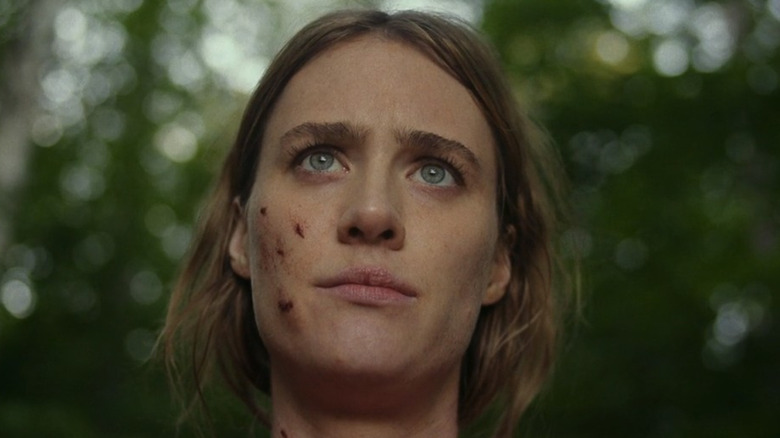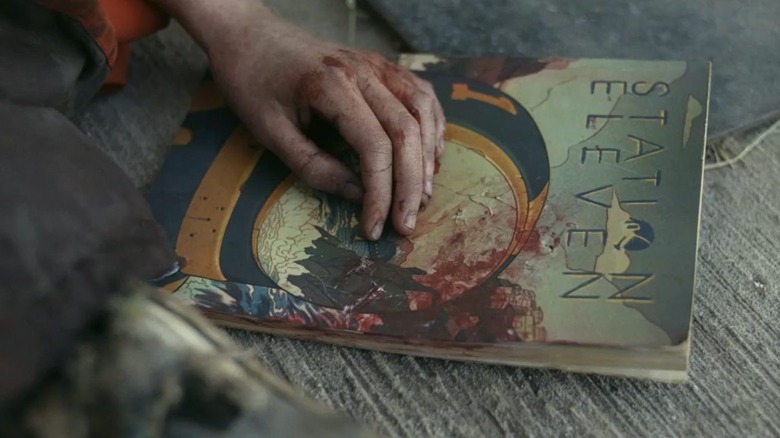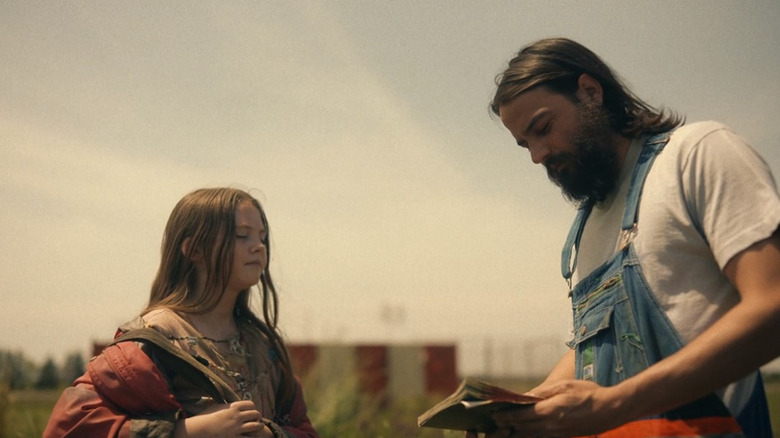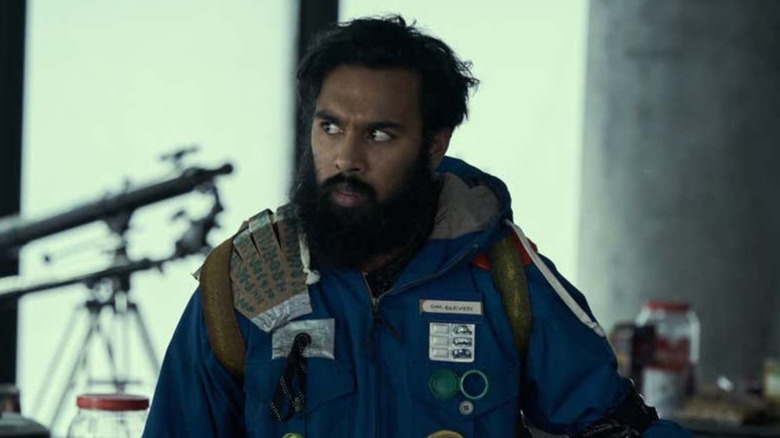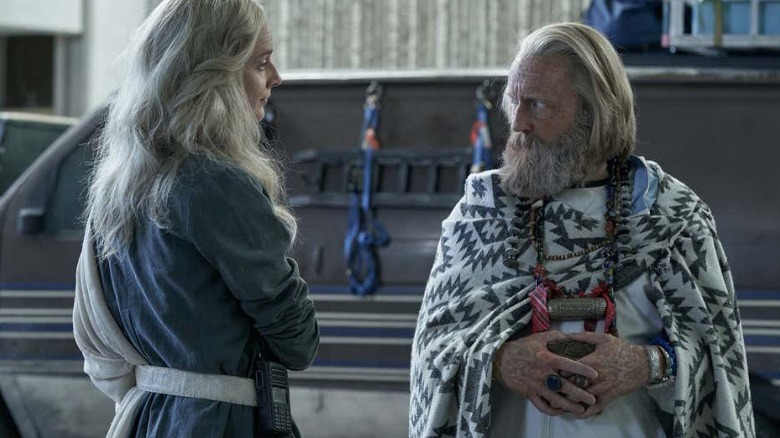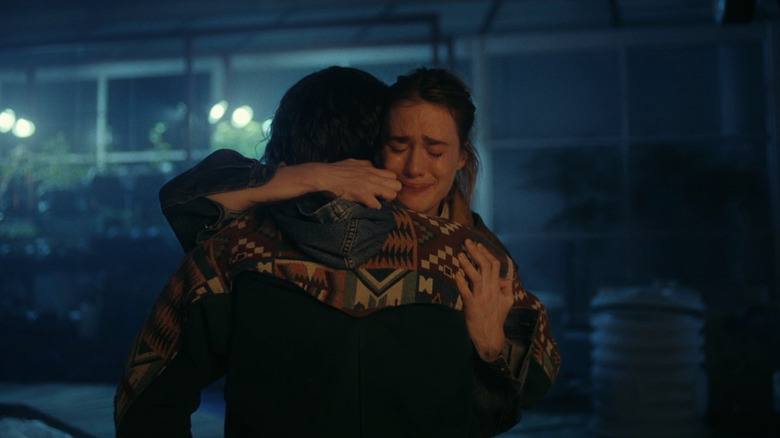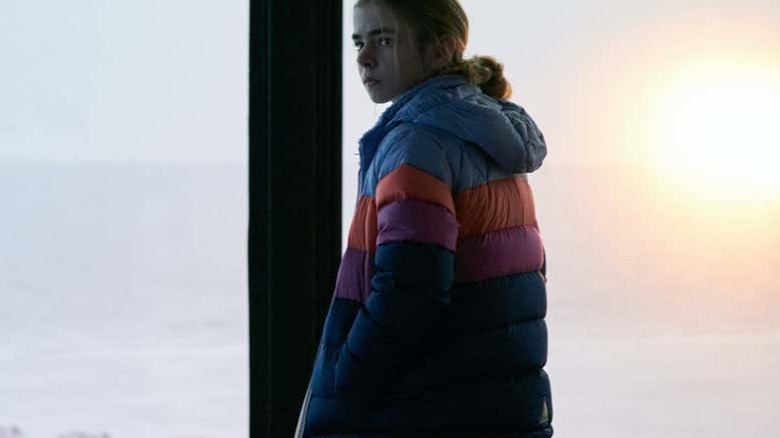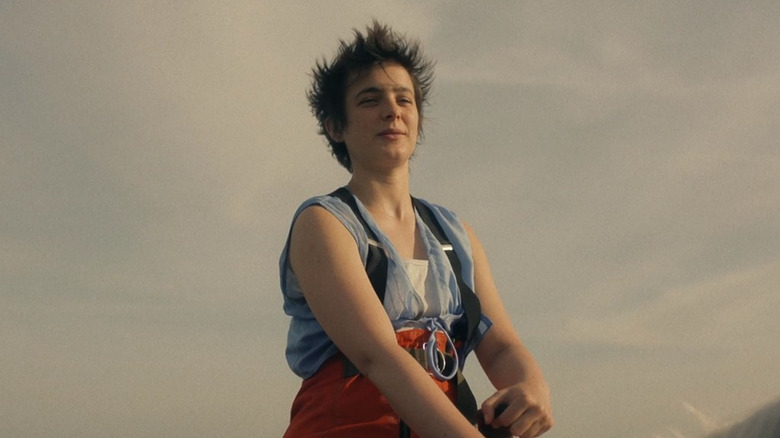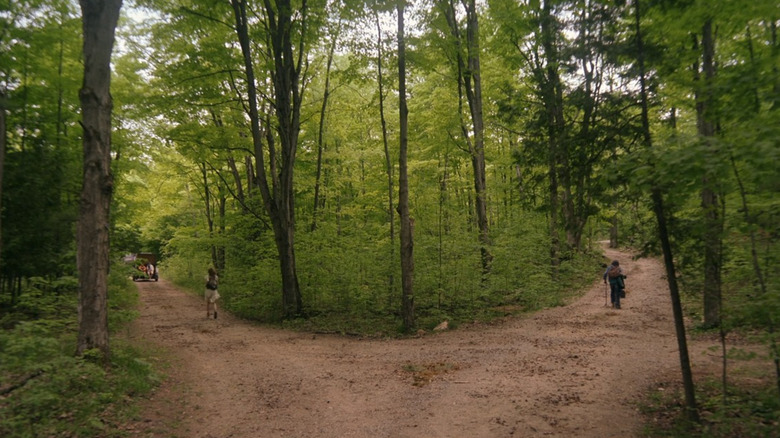The Ending Of Station Eleven Explained
What does it mean to be human in a time when society has failed us? What would we do with ourselves if the internet went down and the lights all went out, and the scale at which we live suddenly diminished? "Station Eleven," the HBO Max miniseries and the 2014 novel by Emily St. John Mandel that it's based on, both tell a paradoxically life-affirming story about 99.99% of the world's population dying. Even though the "Georgian flu" that ends the world in "Station Eleven" is vastly more deadly than the coronavirus, it's a cathartic and destabilizing thrill to watch as characters deal with quarantines, long periods of isolation, and find solace in art.
One of the best parts about "Station Eleven" is that it knows that the apocalypse isn't a story unto itself. Where the vast majority of brutal stories about the collapse of the world like "The Walking Dead" have little message to offer other than, "Hey, wouldn't this suck?" this humane and breathtaking miniseries moves two decades past the brutality and asks much more interesting questions. It wonders how we'd rebuild family from the people we end up with, how we'd tell stories about the world used to be, and how trauma and trust would be intertwined afterward. With no major science fiction, prophecy, or supernatural elements, "Station Eleven" creates something ordinary and transcendent.
The finale brought us to tears, taught us it's still kind of hard to follow Shakespeare, and cast us back out into the real world. It left some lingering questions and perhaps mild confusion after ten episodes. This is the ending of "Station Eleven," explained.
Warning: Major spoiler for HBO's "Station Eleven" miniseries follow.
Station Eleven the graphic novel
The key to understanding the "Station Eleven" miniseries lies in the pages of the graphic novel of the same name that's created by one of the characters. The story within the story serves as a lens through which key moments in several characters lives are refracted and given meaning.
In the graphic novel, a mysterious figure in a spacesuit named Dr. Eleven is taken onto a damaged space station. Dr. Lonegan, the last surviving adult crewmember after a disaster, drinks scotch and talks philosophically to Eleven. An army of children called The Undersea, whose parents were killed in the disaster that damaged the station, antagonize Lonegan and ultimately kill him. Dr. Eleven somewhat passively speaks to both sides and observes everything. Despite its importance, we never precisely learn who Dr. Eleven is under the spacesuit, or get many more specifics of the graphic novel's plot. However, over the epic course of the miniseries, we see the way that a single work of art can impact countless lives.
Miranda begins to write "Station Eleven" to deal with the death of her family in a hurricane, and buries herself in it to avoid connection in her adult life. When she finally gives two copies to Arthur, it heals old wounds and reconnects the two. From there, it becomes a source of meaning and understanding for Kirsten, who adapts it into a play to say things to Jeevan and Frank she's not old enough to say, and a source of madness for Tyler, who turns it into the "prophecy" of a dangerous new quasi-religion.
Won't someone think of the children?
The biggest flaw in "Station Eleven" is that it doesn't make it entirely clear on first viewing what's happening with the army of child followers that Tyler, the "Prophet," has named the Undersea. For the first several episodes, Tyler is a menacing figure who threatens the Traveling Symphony and seemingly sends child suicide bombers. When Kirsten tracks him down and is about to kill him, he claims that while he was injured from a stab wound (that Kirsten gave him), a child named Haley started to have ideas of her own and masterminded the bombing herself, telling the children "the mines erase the past."
Haley is the child in the finale that suddenly arrives at the airport with a bag full of landmines, which she call "beacons for The Prophet." She is ultimately convinced that the Prophecy isn't real when Kirsten shows her the graphic novel it came from. This apparently is enough to subvert whatever cataclysmic plan the children of the Undersea were intent on when they saw Tyler "light the signal" by blowing up the airport tower.
Tyler ultimately leaves with the Undersea, along with his mother, in a happily ever after ending that feels unearned. He might not have ordered the bombing, but he has spent a decade warping children's minds with stories that make them as maniacal as he is about denying the pre-pandemic past. It's difficult for viewers to accept his story of reconciliation with Clark and his mother, especially after spending so much time being filled with dread at his every appearance.
You're going to die and I can't stop it.
Any apocalypse story is one of deep grief. "Station Eleven" might be hitting so many viewers hard right now because it explores grief on a personal scale against a backdrop of grief on a global scale. It uses art to reflect on this directly, as both Kirsten and Tyler play the part of Hamlet in a scene when his mother and uncle ask him why he is so worked about the death of his father? "All that lives must die," his mother says, "passing through nature to eternity."
Just as Kirsten's adaptation of Lonegan's death scene lets Jeevan and Frank say things to each other they might not have stated otherwise, she and Tyler let Shakespeare speak through the ages to get to the heart of loss. Grief is being cast out into a new, changed world. It is the visceral howl of confusion that connects Kirsten in time when Alex has run away or Jeevan has suddenly disappeared. It is an unknowable emptiness buried deep down, or "that within that passeth show." Tears, brooding, anguish, all behavior is "but the trappings and the suits of woe."
"Station Eleven," for all its death and gloom, is a show about the bright calm of humanity reasserting itself over the world and between its shattered characters. The hardest part isn't necessarily the grieving, but moving on with life as a reconstituted version of yourself. Miranda puts her finger on it in an emotional breakdown during a pointless pitch meeting when she says, "The man I love died, and I went to work!?" The hard part, as Hamlet tells his uncle, isn't the clouds but being "too much in the sun."
The past is safe. Everything else changes.
If there's a central conflict in "Station Eleven," it's between the ideologies of Tyler, who wants to destroy all remnants of the past, and Clark, who builds an entire airport city dedicated to preserving everything he can of the pre-pandemic society. What starts as a small collection of dead smartphones and tablets becomes the Museum of Civilization and a way for the story to ruminate on how seemingly good society had it before the fall. At multiple points, characters too young to remember ask Kirsten if phones could really summon cars to give you rides, connect you with anyone on Earth, or show you anything ever written or recorded. She confirms that they could in fact do all that, but also "they weren't that great."
However, just as technology is nothing to blindly worship, it's also not something inherently evil. Tyler is brought little to no catharsis by blowing up the Museum of Civilization's showroom of artifacts. The technology of the Severn City Airport helps save all of its inhabitants but also isolates them. "Station Eleven" invites us to reframe our attitudes and mindfulness of the world of connected possibility we live in by refusing to judge things either way. The Traveling Symphony, which uses a combination of analog and digital instruments like tubas and keytars, presents artists as individuals that straddle the line between the past and future. Like Dr. Eleven, they're sifting through the wreckage for "whatever didn't break."
I have found you nine times before, maybe ten.
It's almost difficult to pay attention to the details of "Unbroken Circle," the finale of "Station Eleven," because you're on the edge of your seat waiting for Jeevan and Kirsten to reunite after being cruelly separated by fate nineteen years before. The miniseries stays true to the spirit and tone of its source material, but by far, the biggest and best departure from the novel is the intertwining of Jeevan and Kirsten's stories, as they interact only briefly in the book. However, the miniseries chooses to build everything around the moment when they wordlessly process seeing one another again and finally hug.
As society discovered during the COVID-19 pandemic that separated many for long periods, reuniting with connections that we haven't seen since "before" can be cathartic. These factors help make this scene one of the most palpably relatable and moving pieces of art in recent memory. It's a testament to some fortuitous timing, as Deadline notes that "Station Eleven" was in development before coronavirus existed, but credit is also due to the brilliant performances by Mackenzie Davis, Matilda Lawler, and Himesh Patel.
I remember damage.
The time-hopping structure of "Station Eleven" is much more than just flashy editing. It's a way for the story to push past basic questions like "what happened to this character?" or "how many people survived?" It's also a brilliant way to depict trauma, which rewires the body and mind in such a way that you can relive the past like it's happening simultaneously with the present. This is a key aspect of Kirsten's emotional journey. For instance, Kirsten relives finding out her parents died while playing Hamlet and even spends the entirety of the standout episode "Goodbye My Damaged Home" interacting with her memory of the first 80 days in Frank's apartment.
A key element of the story within the story is that "Dr. Eleven can't feel time." But that doesn't mean, as the Undersea and Tyler would have you think, that "there is no before," and that the past isn't real or relevant. It means that individuals stumble into an unknown future and carry the weight of all the places they've been with them. The characters of "Station Eleven" float through time in hazy memories, new people every moment from the sheer complexity of experience, a feeling like being "adrift in a stranger's galaxy for a long time." But they find the present again, like home.
I was late, or you were early. Either one.
"Station Eleven" has so many characters and loose ends that several fascinating details await you on a re-watch. There's a city named "St. Deborah by the Water" with a statue of a woman holding a child that makes more sense after watching the whole series, and there's a buried connection that explains a whole lot. It is revealed that Alex is the baby that a woman named Rose gives birth to in the flurry of equinox births, and Tyler is the friend named "Dave" that Rose waits on before she dies giving birth.
It's not clear if either character realizes this, but it gives a fascinating subtext to the immediate bond between Alex and Tyler. That bond, in turn, disrupts Alex and Kirsten's relationship and informs Alex's look of warmth and satisfaction as she watches Tyler reconcile with his own mother, a chance she never had herself. It might seem like it pushes credulity to have this many characters in the same place at the end of the story, with so many coincidental connections, but it makes perfect sense in a world that's only got a few people left. If you cross the same lake in a "wheel" for 20 years, it all eventually becomes like one small town.
Reclaiming the wilderness
In its final shot, "Station Eleven" echoes its beginning. The miniseries begins with images of plant life having overgrown the city of Chicago, the wilderness asserting itself over human civilization, and ends with Kirsten and Jeevan saying goodbye and following two roads diverging in the woods. They forge ahead in a world of quiet solemnity, still beset by post-pandemic chaos, to follow their instinctive paths — Kirsten to entertain, Jeevan to heal.
Jeevan's impulse to stand up and help Arthur in the first scene of the series, despite not being a paramedic, has come full circle as he comforts Kirsten's new mentor, Sarah, as she dies from a heart attack in turn. He gives voice to the message underneath the message of any art, the answer to our deepest existential fear: "You're not alone." Don't be afraid, this beautiful series reminds us, "I find you because I know you, and I know you because we're the same."
